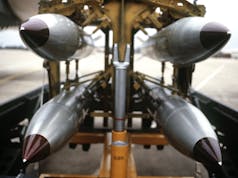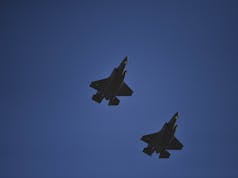Typhoon jets provided fire support to the SDF on the Sunday 21st of October.
That evening, an SDF advance came under fire from an Islamic State strong-point five miles north-east of Abu Kamal.
The Typhoon flight conducted a carefully planned attack with a single Paveway IV, which struck the strong-point and immediately eliminated the threat to the SDF, say the MoD.
Operation Shader
By September 2017, the Ministry of Defence had announced that over 1,000 personnel were engaged in theatre and that the Royal Air Force had conducted around 900 airstrikes, flying over 2,200 sorties, killing 3,000 Islamic State fighters.
Last year, it was reported that the Royal Air Force is operating at its most intense for 25 years in a single theatre of operation which far outstripped the UK involvement in Iraq and Afghanistan – RAF jets have dropped 11 times more bombs (1,276 strikes) on Syria and Iraq in the preceding 12 months than they had in the busiest year of action in Afghanistan a decade previously.
As of March last year, the MoD says the operation has cost the UK taxpayers £265 million so far. As of April 2017, 37 Hellfire missiles, 20 Brimstone missiles, 30 unspecified/other armaments were used in the operation against Islamic State in Iraq and Syria.













Why we should be seriously considering thrust vectoring short term for our Typhoon fleet and increasing the numbers until Tempest is delivered in sufficient numbers sometime in the 2030’s.
https://www.flightglobal.com/news/articles/eurojet-pushes-thrust-vectoring-technology-for-typhoon-333501/
TVC has been dropped for good reason. Post stall manoeuvring is very impressive at air shows, but suicidal in combat. That became apparent to the RAF and USAF when IAF Su-30MKIs began bilateral exercises. Speed is life.
Agreed Glenn, with the advent of modern targeting systems and missiles, post stall manoeuvring makes an aircraft the size of a Flanker little more than a floundering airborne whale of a static target!
They made the right decision back in the 1980’s when they decided to concentrate on supersonic manoeuvrability with the Typhoon.
if you read the linked article you’d know that thrust vectoring isn’t about post stall manoeuvrability, its about engine efficiency – reduced fuel consumption – increased thrust – reduced temperatures leading to increased life and finally higher speeds in super cruise – all good stuff and of course you get silly crowd pleasing antics at airshows for free!!
I might be mistaken but I do remember everyone saying we lost against the Indians during the exercise.
Thanks for posting the article it is very interesting and shows that there are advantages of TVC beyond manoeuvring aircraft. Even if it was just for show if it boosts sales then it still has a place and like conformal fuel tanks (which also don’t seem to be a priority for the raf) these options are available on other aircraft not typhoons. Air combat is not a day to day occurrence and therefore deterrence and prowess are sometimes important for buyers. In the Middle East a lot of purchases seem to be to boost who has the best kit. From an RAF point of view I would also say even if CFTs, TVC gave a small edge/increase in performance I would prefer to have it in combat there is no points for second place
I think having a striker 2 helmet is much more beneficial in combat, air to air or air to ground, then thrust vectoring, vectoring nozzles also come with a significant weight penalty.
Read the Link Robert!
That article is 9 years old Nigel.
Correct Robert,
Hence the reason for posting it to show what has been available to improve the Typhoons performance further still and we still don’t have it fitted yet.
Gents, I do agree that TVC and conformal fuel tanks would be an additional benefit to an already excellent airframe. However, the RAF have quite rightly concentrated on enhancing the aircraft’s capabilities beyond just an air to air fighter with Project Centurion. OK, this was pushed due to the accelerated retirement of Tornado and the need for a ground attack platform before the F35 became available. I believe the main reason for not pushing for TVC and CFC is due to Meteor and the Captor-E radar. These two have soaked up the majority of the available budget and quite rightly in my opinion. With these two enhancements alone will ensure the aircraft remains competitive against 5th gen aircraft. Aircraft like the SU30 series i.e. 4.5 gen aircraft will be sitting ducks against this combination and more importantly detected and engaged far earlier than Typhoon could be. The PIRATE, Striker 2 helmet and ASRAAM combination will make sure dog fighting (if it comes to that) will be done in an environment that favours the Typhoon.
The Typhoon will be cruising either high sub-sonically or super cruising, so the engagement will be about who sees who first, firing, then quickly getting out of harms way ready for round two. Therefore high speed turns with the minimum amount of energy loss will be key. Once Captor-EE, Meteor and Striker 2 are fully embedded, I’m sure other “aero” packages will be looked at, the engine enhancement being the first on the list as this requires no airframe modifications unlike TVC, CFC or LERX.
The Radar and Engine improvement are definitely its two most important upgrades.
Captor E seems to be taking forever to develop, I’m not expecting it to be deployed until 2020. Its going to need to be the most advance radar on the world to justify all of these delays, apparently the UK has been pushing to improve its electronic warfare capabilities which pushed back development.
Yes, I’ve heard that it’s delayed by at least 13 months due to a number of issues. One of the prime hiccups is the different requirements between Germany and the UK. Not sure what differences these could be, but I know we have asked for more ground moving target mapping capabilities. The other issue it’s facing is that the front end computer it uses is now out of date and the new replacement is currently going through the Release to Service hurdles.
There is hope that these problems won’t hold up the Kuwati delivery, as they were earmarked to have the first P3E standard aircraft. This is the full Centurion capability, with Striker 2,Meteor and Captor-E. I have also heard that like the F35, the first iteration of Captor-E will be “quite” basic but will have a number of planned software and hardware developments to make sure none of its components face obsolescence problems and that it stays at the forefront of capability.
The Syrian Democratic Forces aren’t in it to promote democracy, that’s for certain.